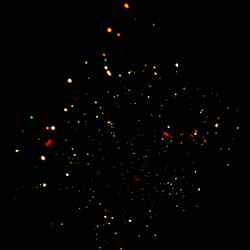
X-ray image of the Chandra Deep Field-North. Image credit: NASA/PSU Click to enlarge
Data from X-ray observatory surveys show that black holes are much more numerous and evolved differently than researchers would have expected, according to a Penn State astronomer.
“We wanted a census of all the black holes and we wanted to know what they are like,” said Niel Brandt, professor of astronomy and astrophysics. “We also wanted to measure how black holes have grown over the history of the Universe.”
Brandt and other researchers have done just that by looking at a patch of sky in the Northern hemisphere called the Chandra Deep Field-North, using NASA’s Chandra X-ray Observatory and a similar patch in the Southern hemisphere called the Extended Chandra Deep Field-South. Surveys also are being carried out in other parts of the sky using both Chandra and the European Space Agency’s X-ray Multi-Mirror Mission-Newton.
The researchers looked at X-ray emissions because areas around black holes emit X-rays as well as visible light. The penetrating nature of X-rays provides a direct way to identify the black holes. Using X-rays also enables astronomers to pinpoint the black holes at the centers of galaxies without their signal being washed out by the visible light coming from a galaxy’s stars, Brandt told attendees at the annual meeting of the American Association for the Advancement of Science in St. Louis, Mo. Feb. 17. The black holes they studied were those that reside at the centers of galaxies and are actively emitting X-rays, therefore they are called active galactic nuclei.
“We find active super massive black holes at the centers of massive galaxies,” said Brandt. “Our galaxy also has its own black hole at its center measuring 2.6 million solar masses. Our black hole is not active today, but we presume it was active in the past.”
These deep, extragalactic X-ray surveys looked at carefully chosen patches of sky, that are largely free of anything that might interfere with obtaining the X-ray data. Chandra looked at the Chandra Deep Field-North — an area of sky two thirds the size of the full Moon — for the time span of 23 days over a two-year period. The researchers detected about 600 X-ray sources. After comparing the X-ray images with optical images of exactly the same slice of sky taken by the Hubble Space Telescope, nearly all 600 point sources corresponded to optical galaxies, suggesting that the black holes that were sources for the X-ray signature were in the centers of galaxies.
“X-ray astronomers are doing better than anyone else by about a factor of ten, in identifying these active galactic nuclei” said Brandt. “With more time we could do even better, going even deeper.”
What the researchers found was that super massive black holes are more numerous than we might have expected. They also found that black holes evolved differently than astronomers expected prior to the Chandra work. Extrapolating from the 600 black holes found by Chandra, Brandt suggests that there are about 300 million super massive black holes in the whole sky.
The existence of so many black holes, confirmed that what was once thought to be a truly diffuse cosmic X-ray background radiation, actually comes from point sources.
In the 1960s, astronomers discovered quasars, very distant, highly luminous black holes, in galactic centers. Quasars, initially called quasi-stellar radio sources, were studied intensely. Researchers soon realized that only some of these objects were radio emitters and that they formed early in the history of the Universe.
“While quasars are spectacular, they are not representative of typical active galactic nuclei,” said Brandt. “Now, using Chandra and other X-ray observatories, we can find and study the moderate-luminosity, typical active galactic nuclei in the distant, high-redshift Universe.”
Quasars and moderate-luminosity active galactic nuclei also evolved differently. Quasars are a phenomenon of young galaxies, while moderate-luminosity, active galactic nuclei peaked later in cosmic time.
“We would like to know if active galactic nuclei change over cosmic time,” said Brandt. “Do black holes feed and grow in the same way over the history of the Universe?”
Researchers looked at the relative amount of power coming out in X-rays compared to other wavelengths and found that this ratio does not change over 13 billion years of time. They looked at the X-ray spectra and found that these also did not change through time.
“Despite the enormous changes in the space density of back holes, the individual engines powering active galactic nuclei are remarkably stable,” Brandt said.
Brandt believes that Chandra could observe the Chandra Deep Field-North for a longer period of time and obtain more sensitive, deeper data. This would bring to light galaxies that are currently obscured. It would also gather more X-rays allowing better X-ray spectral and variability analyses. With more sensitive probing, the researchers are also detecting an increasing number of non-active galaxies like our own.
“Chandra has worked well for six years now,” said Brandt. “There is no reason why Chandra and Newton cannot continue to observe for another 10 or more years.”
Original Source: PSU News Release

hi! The babes are here! This is my favorite site to visit. I make sure I am alone in case I get too hot. Post your favorite link here.